CCNA 1 v6 - Chapter 3 Exam Answers 2019 – 100% Full

1. What method can be used by two computers to ensure that packets are not dropped because too much data is being sent too quickly?
- encapsulation
- flow control*
- access method
- response timeout
2. What type of communication will send a message to all devices on a local area network?
- broadcast*
- multicast
- unicast
- allcast
3. What process is used to place one message inside another message for transfer from the source to the destination?
- access control
- decoding
- encapsulation*
- flow control
4. A web client is sending a request for a webpage to a web server. From the perspective of the client, what is the correct order of the protocol stack that is used to prepare the request for transmission?
- HTTP, IP, TCP, Ethernet
- HTTP, TCP, IP, Ethernet*
- Ethernet, TCP, IP, HTTP
- Ethernet, IP, TCP, HTTP
5. Which statement is correct about network protocols?
- Network protocols define the type of hardware that is used and how it is mounted in racks.
- They define how messages are exchanged between the source and the destination.*
- They all function in the network access layer of TCP/IP.
- They are only required for exchange of messages between devices on remote networks.
6. Which statement is true about the TCP/IP and OSI models?
- The TCP/IP transport layer and OSI Layer 4 provide similar services and functions.*
- The TCP/IP network access layer has similar functions to the OSI network layer.
- The OSI Layer 7 and the TCP/IP application layer provide identical functions.
- The first three OSI layers describe general services that are also provided by the TCP/IP internet layer.
7. What is an advantage of using standards to develop and implement protocols?
- A particular protocol can only be implemented by one manufacturer.
- Products from different manufacturers can interoperate successfully.*
- Different manufacturers are free to apply different requirements when implementing a protocol.
- Standards provide flexibility for manufacturers to create devices that comply with unique requirements.
8. What three application layer protocols are part of the TCP/IP protocol suite? (Choose three.)
- ARP
- DHCP *
- DNS *
- FTP*
- NAT
- PPP
9. What are proprietary protocols?
- protocols developed by private organizations to operate on any vendor hardware
- protocols that can be freely used by any organization or vendor
- protocols developed by organizations who have control over their definition and operation*
- a collection of protocols known as the TCP/IP protocol suite
10. What is an advantage of network devices using open standard protocols?
- Network communications is confined to data transfers between devices from the same vendor.
- A client host and a server running different operating systems can successfully exchange data.*
- Internet access can be controlled by a single ISP in each market.
- Competition and innovation are limited to specific types of products.
11. Refer to the exhibit. If Host1 were to transfer a file to the server, what layers of the TCP/IP model would be used?
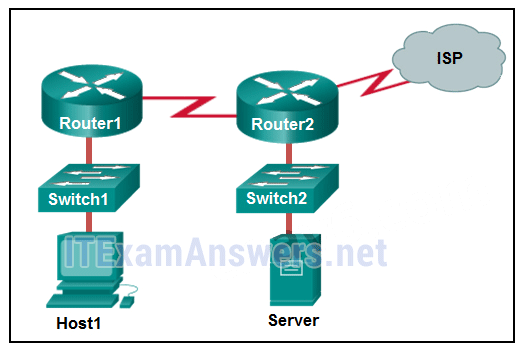

- only application and Internet layers
- only Internet and network access layers
- only application, Internet, and network access layers
- application, transport, Internet, and network access layers*
- only application, transport, network, data link, and physical layers
- application, session, transport, network, data link, and physical layers
12. Which three layers of the OSI model are comparable in function to the application layer of the TCP/IP model? (Choose three.)
- application *
- presentation *
- session*
- transport
- data link
- physical
- network
13. At which layer of the OSI model would a logical address be encapsulated?
- physical layer
- data link layer
- network layer*
- transport layer
14. At which layer of the OSI model would a logical address be added during encapsulation??
- physical layer
- data link layer
- network layer*
- transport layer
15. Which PDU format is used when bits are received from the network medium by the NIC of a host?
- file
- frame*
- packet
- segment
16. Which PDU is processed when a host computer is de-encapsulating a message at the transport layer of the TCP/IP model?
- bits
- frame
- packet
- segment*
17. Refer to the exhibit. HostA is attempting to contact ServerB. Which two statements correctly describe the addressing that HostA will generate in the process? (Choose two.)
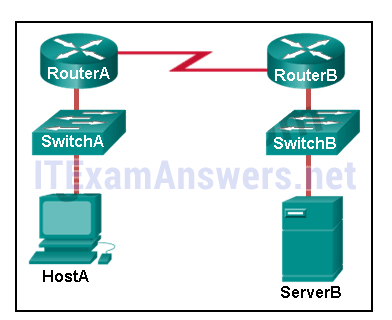

- A packet with the destination IP address of RouterB.
- A frame with the destination MAC address of SwitchA.
- A packet with the destination IP address of RouterA.
- A frame with the destination MAC address of RouterA.*
- A packet with the destination IP address of ServerB.*
- A frame with the destination MAC address of ServerB.
18. Which address does a NIC use when deciding whether to accept a frame?
- source IP address
- source MAC address
- destination IP address
- destination MAC address*
- source Ethernet address
19. What will happen if the default gateway address is incorrectly configured on a host?
- The host cannot communicate with other hosts in the local network.
- The switch will not forward packets initiated by the host.
- The host will have to use ARP to determine the correct address of the default gateway.
- The host cannot communicate with hosts in other networks.*
- A ping from the host to 127.0.0.1 would not be successful.
20. Which characteristic describes the default gateway of a host computer?
- the logical address of the router interface on the same network as the host computer*
- the physical address of the switch interface connected to the host computer
- the physical address of the router interface on the same network as the host computer
- the logical address assigned to the switch interface connected to the router
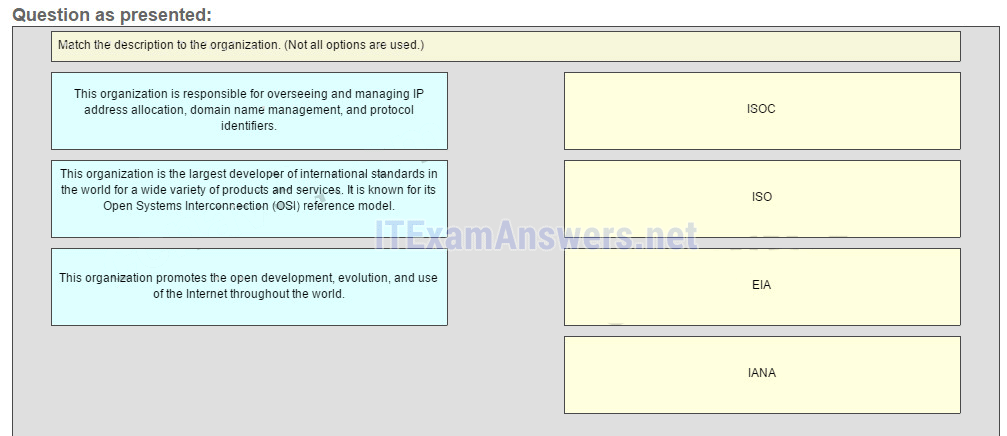
21. Match the description to the organization. (Not all options are used.)
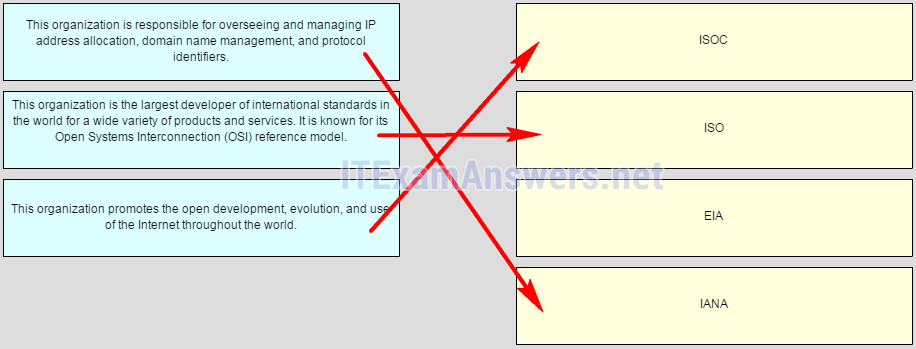
ISOC -> The organization promotes the open development, evolution, and use of the internet throughout the world
ISO -> This organization is the largest developer of international standars in the world for a wide variety of products and services. It is know for its Open System Interconection (OSI) reference model.
IANA -> This organization is responsible for overseeing and managing IP address allocation, domain name management, and protocol identifiers
ISO -> This organization is the largest developer of international standars in the world for a wide variety of products and services. It is know for its Open System Interconection (OSI) reference model.
IANA -> This organization is responsible for overseeing and managing IP address allocation, domain name management, and protocol identifiers
22. Match the protocol function to the description while taking into consideration that a network client is visiting a web site. (Not all options are used.)
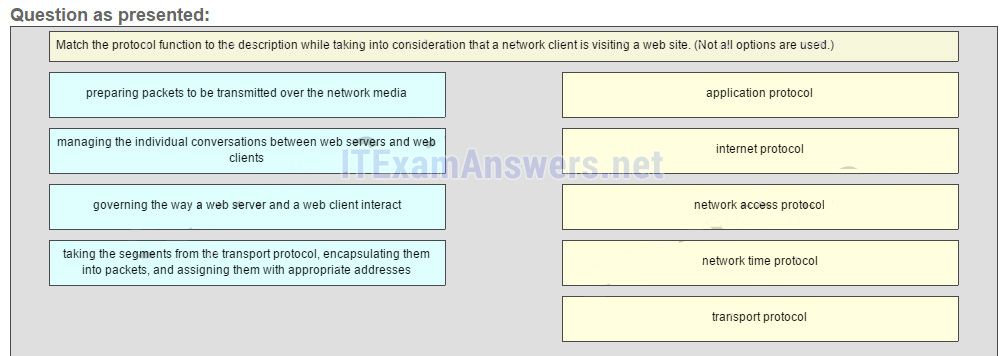



Place the options in the following order:
governing the way a web server and a web client interact –> application protocol
taking the segments from transport protocol, encapsulating them into packets, and assigning them with appropriate addresses –> internet protocol
preparing packets to be transmitted over the network media –> network access protocol
– not scored –
managing the individual conversations between web servers and web clients –> transport protocol
governing the way a web server and a web client interact –> application protocol
taking the segments from transport protocol, encapsulating them into packets, and assigning them with appropriate addresses –> internet protocol
preparing packets to be transmitted over the network media –> network access protocol
– not scored –
managing the individual conversations between web servers and web clients –> transport protocol
23. Match each description to its corresponding term. (Not all options are used.)
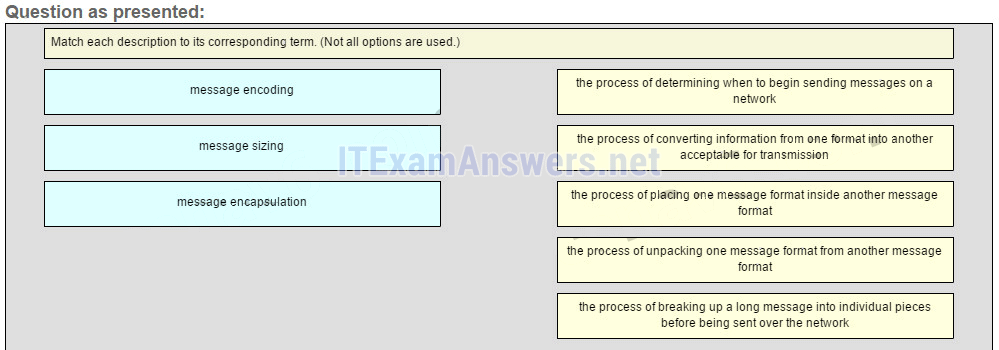



Place the options in the following order:
– not scored –
message encoding -> the process of converting information from one format into another acceptable for transmission
message encapsulation -> the process of placing one message format inside another message format
– not scored –
message sizing -> the process of breaking up a long message into individual pieces before being sent over the network
– not scored –
message encoding -> the process of converting information from one format into another acceptable for transmission
message encapsulation -> the process of placing one message format inside another message format
– not scored –
message sizing -> the process of breaking up a long message into individual pieces before being sent over the network
Other Quetions
24. A computer in a given network is communicating with a specific group of computers. What type of communication is this?
- broadcast
- multicast*
- unicast
- ARP
- HTTP
25. Which protocol is responsible for controlling the size and rate of the HTTP messages exchanged between server and client?
- HTTP
- ARP
- TCP*
- DHCP
26. A user is viewing an HTML document located on a web server. What protocol segments the messages and manages the segments in the individual conversation between the web server and the web client?
- DHCP
- TCP*
- HTTP
- ARP
27. Which IEEE standard enables a wireless NIC to connect to a wireless AP that is made by a different manufacturer?
- 802.1
- 802.11*
- 802.3
- 802.2
28. What is a function of Layer 4 of the OSI model?
- to specify the packet type to be used by the communications
- to apply framing information to the packet, based on the attached media
- to represent data to the user, including encoding and dialog control
- to describe the ordered and reliable delivery of data between source and destination*
29. What is a benefit of using a layered model for network communications?
- fostering competition among device and software vendors by enforcing the compatibility of their products*
- enhancing network transmission performance by defining targets for each layer
- avoiding possible incompatibility issues by using a common set of developing tools
- simplifying protocol development by limiting every layer to one function
30. What is the general term that is used to describe a piece of data at any layer of a networking model?
- frame
- packet
- protocol data unit*
- segment
31. Which statement accurately describes a TCP/IP encapsulation process when a PC is sending data to the network?
- Data is sent from the internet layer to the network access layer.
- Packets are sent from the network access layer to the transport layer.
- Segments are sent from the transport layer to the internet layer.*
- Frames are sent from the network access layer to the internet layer.
32. What statement describes the function of the Address Resolution Protocol?
- ARP is used to discover the IP address of any host on a different network.
- ARP is used to discover the IP address of any host on the local network.
- ARP is used to discover the MAC address of any host on a different network.
- ARP is used to discover the MAC address of any host on the local network.*
33. Which address provides a unique host address for data communications at the internet layer?
- data-link address
- logical address*
- Layer 2 address
- physical address
34. Which protocol is used by a computer to find the MAC address of the default gateway on an Ethernet network?
- ARP*
- TCP
- UDP
- DHCP
35. If the default gateway is configured incorrectly on the host, what is the impact on communications?
- The host is unable to communicate on the local network.
- The host can communicate with other hosts on the local network, but is unable to communicate with hosts on remote networks.*
- The host can communicate with other hosts on remote networks, but is unable to communicate with hosts on the local network.
- There is no impact on communications.
36. Open the PT Activity. Perform the tasks in the activity instructions and then answer the question. Based on the configured network, what IP address would PC1 and PC2 use as their default gateway?
- 192.168.1.2
- 10.1.1.1
- 172.16.1.1
- 192.168.1.1*
- 192.168.1.10
37. A user sends an HTTP request to a web server on a remote network. During encapsulation for this request, what information is added to the address field of a frame to indicate the destination?
- the MAC address of the default gateway*
- the IP address of the destination host
- the MAC address of the destination host
- the IP address of the default gateway
38. Refer to the exhibit. PC-A and PC-B are both in VLAN 60. PC-A is unable to communicate with PC-B. What is the problem?
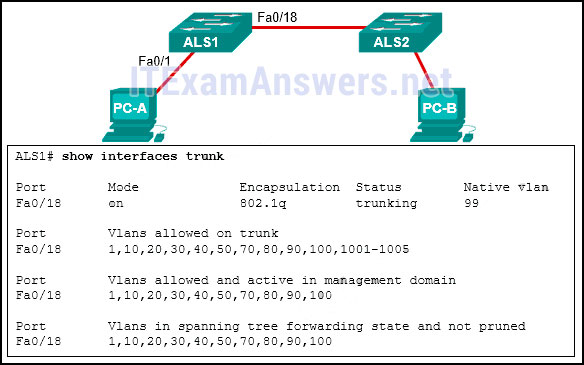

- The native VLAN is being pruned from the link.
- The trunk has been configured with the switchport nonegotiate command.
- The native VLAN should be VLAN 60.
- The VLAN that is used by PC-A is not in the list of allowed VLANs on the trunk.*
39. Which command is used to remove only VLAN 20 from a switch?
- no switchport access vlan 20
- no vlan 20*
- delete vlan.dat
- delete flash:vlan.dat
CCNA 1 v6 - Chapter 3 Exam Answers 2019 – 100% Full
 Reviewed by Mouad
on
07:19:00
Rating:
Reviewed by Mouad
on
07:19:00
Rating:
 Reviewed by Mouad
on
07:19:00
Rating:
Reviewed by Mouad
on
07:19:00
Rating:




Aucun commentaire: